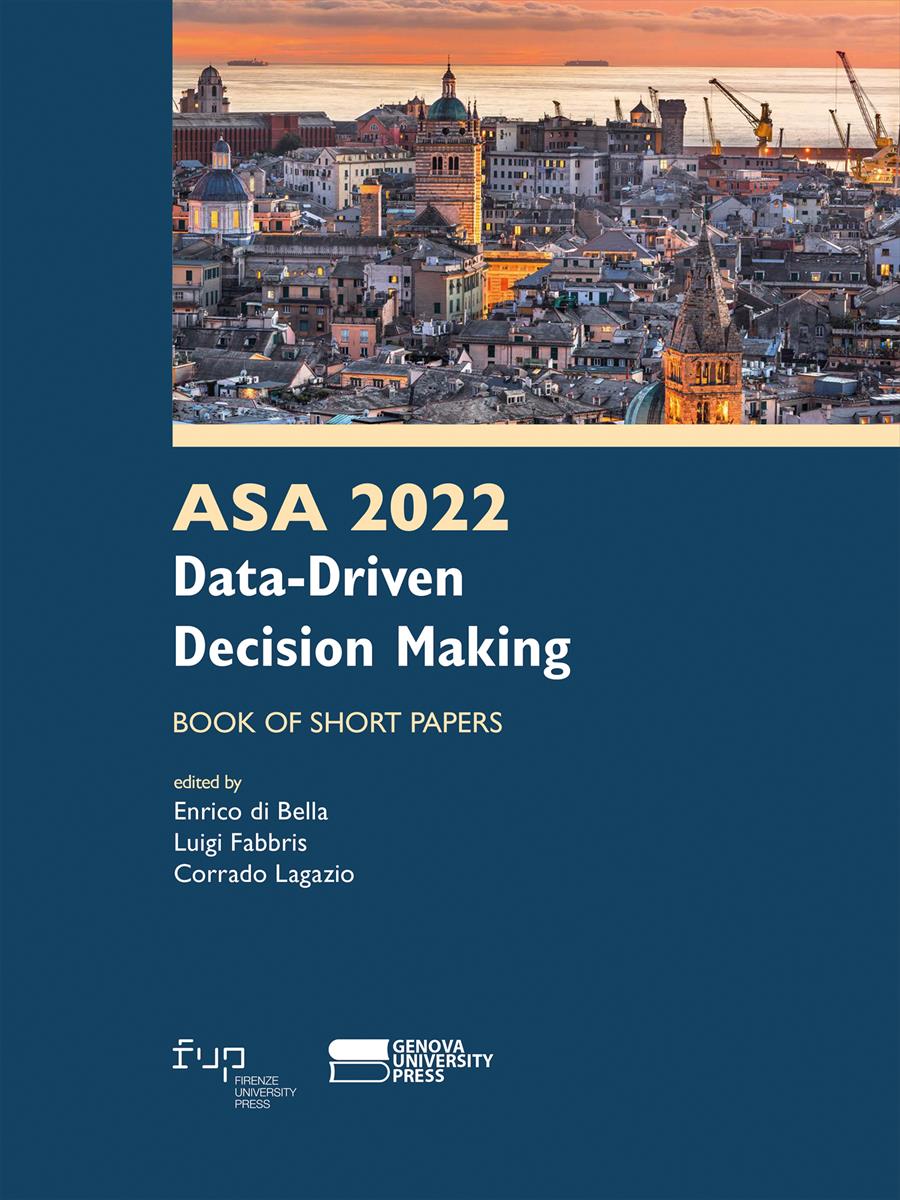- ASA 2022 Data-Driven Decision Making
- Edited by Enrico di Bella, Luigi Fabbris, Corrado Lagazio
Access to emergency care services and inequalities in living standards: Some evidence from two Italian northern regions
- Andrea Marino
- Marco Pesce
- Raffaella Succi
- © 2023 Author(s) |
- CC BY 4.0
- DOI: 10.36253/979-12-215-0106-3.24
Rapid access to emergency medical care is crucial in reducing the implications of negative health events in terms of both mortality and disability. Thus, in a well-designed health system the geographical distribution of emergency care services should be able to minimize the share of people whose access time lies beyond critical thresholds. In spite of this, statistical information measuring accessibility to emergency care services at a highly disaggregated level is unavailable in Italy. This paper makes a step in filling this gap, by providing geographically detailed estimates of accessibility in two northern regions, Liguria and Lombardia. To do so, we use three data sources: 1) georeferenced population data measured at the currently most possible detailed level (census enumeration areas, CEAs) from the 2011 Population Census; 2) open data on location of emergency care services; 3) crowdsourced data on road travel distances. Elaborating these data with an efficient algorithm based on open source routing machine provides us with a clear mapping of particularly disadvantaged areas. We find that in 2013 the population share whose access time to emergency care services lies beyond a critical –and policy relevant- threshold of 60 minutes is fairly limited (about 0.1% in both regions). Regional differences emerge when setting lower thresholds. We briefly discuss how accessibility may have evolved in recent years, based upon some conjecture on population dynamics at the CEA level and updated information on emergency care centers. Finally, we analyze how differences in accessibility are related to a set of characteristics describing the population’s living conditions. Different results emerge. In particular, older and less educated people in Liguria face significantly lower access to emergency care. Overall, our results suggest that spatial differences in accessibility -within and between regions- should be considered a relevant determinant of health inequality.
- Keywords:
- emergency care accessibility,
- health inequalities,
- efficient routing algorithms on open (big) data,
ISTAT, Italian National Institute of Statistics, Italy - ORCID: 0000-0002-9854-7885
ISTAT, Italian National Institute of Statistics, Italy - ORCID: 0000-0002-8926-7128
ISTAT, Italian National Institute of Statistics, Italy
- Arcaya M.C., Arcaya A.L., Subramanian V. (2015). Inequalities in health: definitions, concepts, and theories. Global Health Action, 8(1).
- Bruzzi S., Ivaldi E., Santagata M. (2022). Measuring regional performance in the Italian NHS: Are disparities decreasing ? Social Indicators Research. 159, pp. 1057-1084.
- Dufour I., Chouinard M.C., Dubuc N., Beaudin J., Lafontaine S., Hudon C. (2019). Factors associated with frequent use of emergency-department services in a geriatric population: a systematic review. BMC Geriatrics, 19:185.
- Garattini L., Badinella Martini M., Zanetti M. (2022). The Italian NHS at regional level: same in theory, different in practice. The European Journal oh Health Economics. 23, pp. 1-5.
- Hart J.T. (1971). The inverse care law. The Lancet. 297(7696), pp. 405-412.
- Kisiala W., Racka I., Suszynska K. (2022). Population Access to Hospital Emergency Departments: The Spatial Analysis in Public Health Research. Int. J. Environ. Res. Public Health, 19(3), 1437.
- Lilley R., et al. (2019). Geographical and population disparities in timely access to prehospital and advanced level emergency care in New Zealand: a cross-sectional study. BMJ Open, 9.
- Luxen D., Vetter C. (2011). Real-time routing with OpenStreetMap data. Proceedings of the 19th ACM SIGSPATIAL International Conference on Advances in Geographic Information Systems.
- Marmot M. (2005). Social determinants of health inequalities. Lancet, 365(9464), pp. 1099-104.
- Pesce M., Succi R. (2016). L’accessibilità geografica dei servizi di pronto soccorso e le condizioni socio-economiche della popolazione- Poster presented at the 2016 MiLes Conference, Milan,
- Salvucci G., Lombardo G. (2016). Molise quotidianamente resiliente, analisi demografiche in una prospettiva gis. Conferenza ESRI Italia 2016. Conference paper available at the web address: https://www.esriitalia.it/images/pdf/conferenza2016/GianluigiSalvu
- Salvucci G., Lombardo G. (2017). Il ritardo che costa la vita: analisi dell’accessibilità ai pronto soccorso. Conferenza ESRI Italia 2017. Conference paper available at the web address: https://www.esriitalia.it/images/pdf/conferenza2017/GianluigiSalvucci
- Silva K., Padeiro M. (2020). Assessing inequalities in geographical access to emergency medical services in metropolitan Lisbon: a cross-sectional and ecological study. BMJ Open, 10.
- Tang X., Deng Y., Yang H., Tian F., Li Y., Pan J. (2021). Spatial accessibility to emergency care in Sichuan province in China. Geospatial Health, 15(2), pp. 274-284.
- Tolpadi A., et al. (2022). National travel distances for emergency care. BMC Health Services Research, 22, 388.
Chapter Information
Chapter Title
Access to emergency care services and inequalities in living standards: Some evidence from two Italian northern regions
Authors
Andrea Marino, Marco Pesce, Raffaella Succi
Language
English
DOI
10.36253/979-12-215-0106-3.24
Peer Reviewed
Publication Year
2023
Copyright Information
© 2023 Author(s)
Content License
Metadata License
Bibliographic Information
Book Title
ASA 2022 Data-Driven Decision Making
Book Subtitle
Book of short papers
Editors
Enrico di Bella, Luigi Fabbris, Corrado Lagazio
Peer Reviewed
Publication Year
2023
Copyright Information
© 2023 Author(s)
Content License
Metadata License
Publisher Name
Firenze University Press, Genova University Press
DOI
10.36253/979-12-215-0106-3
eISBN (pdf)
979-12-215-0106-3
eISBN (xml)
979-12-215-0107-0
Series Title
Proceedings e report
Series ISSN
2704-601X
Series E-ISSN
2704-5846
